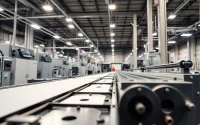Unveiling the Essentials of Machine Vision: Applications, Benefits, and Technologies
Understanding Machine Vision
In an era defined by rapid technological advancement, machine vision stands out as a pivotal technology that enables machines to ‘see’ and interpret the visual world around them. This ability to process images and make swift decisions is setting new standards in efficiency and accuracy across various industries, from manufacturing to healthcare. In this article, we explore the intricacies of machine vision, its components, applications, and the future trends that could reshape its landscape.
What is Machine Vision?
Machine vision is the technology that allows computers to interpret visual information, much like humans. This field encompasses a range of devices and systems, designed to capture and analyze visual data for various applications. At its core, machine vision involves the integration of cameras, sensors, and software algorithms that enable machines to perform complex visual tasks such as inspection, measurement, and recognition.
In practice, a typical machine vision system consists of a camera that captures images, a processing unit that analyzes these images, and an output that can trigger actions based on the analysis. For example, in a manufacturing plant, a machine vision system can identify defective products moving along an assembly line, thereby ensuring high-quality standards are consistently met.
How Machine Vision Differentiates from Computer Vision
While often used interchangeably, the terms machine vision and computer vision refer to distinct areas of technology. Machine vision is primarily concerned with automating specific tasks within industrial settings, such as quality control or robotic guidance. It utilizes predefined algorithms to achieve consistent outcomes based on visual data, making it suited for deterministic environments.
On the other hand, computer vision is a broader field that enables machines to analyze and interpret visual information from the world, often using techniques from artificial intelligence. It encompasses applications like facial recognition, scene understanding, and autonomous navigation, which require the system to learn and adapt based on dynamic environments.
Key Components of a Machine Vision System
A robust machine vision system is built on several key components:
- Imaging Devices: Cameras or sensors are the frontline components, capturing images or video streams. Various types of cameras—such as line scan, area scan, and 3D cameras—are selected based on the application requirements.
- Lighting: Proper illumination is crucial for ensuring image quality. Light sources are tailored to the specific characteristics of the object being inspected, helping to enhance contrast and visibility.
- Processing Unit: This component includes hardware and software that analyze the captured images. Algorithms used may involve deep learning, pattern recognition, or simple pixel analysis, depending on application complexity.
- Output Interface: The results of the processing are communicated to other systems or operators, often triggering automated actions or generating reports.
Applications of Machine Vision
Machine vision finds applications in a plethora of industries, delivering enhanced efficiency and accuracy. Let’s explore some of the most prominent use cases:
Quality Control and Inspection
One of the foremost applications of machine vision is in quality control. By analyzing products in real-time, machine vision systems can detect defects and variations that are imperceptible to the human eye. For instance, in the food and beverage industry, machine vision technology can inspect seals on bottles, ensuring they are intact to prevent contamination.
Such automated inspections not only speed up production lines but also significantly reduce the number of faulty products reaching consumers. These systems can be programmed to meet specific quality standards consistently, providing manufacturers with an edge in maintaining product integrity.
Barcode and Label Reading
Machine vision systems equipped with advanced imaging technology are instrumental in reading barcodes and labels at high speeds. This capability is critical in warehouse automation and logistics, where accurate tracking of inventory is paramount.
Integrating machine vision for barcode reading enables real-time data capture, enhancing inventory management and streamlining supply chain operations. Furthermore, systems can be adapted to read various barcode types, making them versatile tools in various commercial environments.
Robotic Guidance and Automation
Machine vision is heavily utilized in robotics for navigation and manipulation tasks. In industrial robotics, for example, a machine vision system can guide robotic arms to assemble parts with precision by continuously providing feedback on the position of items. Techniques such as image processing allow robots to adapt to changes in the environment, ensuring greater accuracy in operations.
This automation significantly reduces labor costs and enhances productivity by allowing machines to perform repetitive tasks at a higher speed and with fewer errors than human workers.
Technological Advances in Machine Vision
The machine vision industry is continuously evolving, thanks to rapid advancements in technology. Key areas of development include:
Integration with Artificial Intelligence
The infusion of artificial intelligence into machine vision systems is revolutionizing the field. AI algorithms can enhance decision-making capabilities by allowing systems to learn from data inputs over time. This means that rather than just following pre-set rules, machine vision systems can adapt and improve their performance based on past experiences.
For example, machine vision systems in quality control can become increasingly effective over time, learning from previous inspections to minimize false positives and negatives. This adaptability is crucial in industries like automotive manufacturing, where precision is critical for safety.
Development of 3D Machine Vision Systems
3D machine vision systems are another notable advancement, offering enhanced depth perception and spatial awareness compared to traditional 2D systems. These systems enable more complex analyses, such as recognizing and inspecting items regardless of their orientation. They are invaluable in applications where accurate dimensioning is necessary, such as when assembling components in manufacturing.
Advancements in the technology have also led to improved accuracy and speed in 3D modeling, making these systems more accessible and cost-effective for businesses of all sizes.
Future Trends in Machine Vision Technologies
Looking forward, several trends are poised to shape the future of machine vision:
- Increasing Use of Deep Learning: As understanding and capabilities in deep learning expand, more machine vision applications will leverage neural networks for enhanced performance in tasks like object recognition and classification.
- Smart Vision Systems: The incorporation of IoT technology into machine vision systems will facilitate real-time monitoring and remote management, providing businesses with greater operational efficiency.
- Enhanced User Interfaces: Future machine vision software will likely focus on user-friendliness, enabling non-technical personnel to interact with complex systems more easily, thus broadening accessibility and applicability across industries.
Challenges in Implementing Machine Vision
Despite the benefits, adopting machine vision systems comes with its set of challenges, including:
Technical Limitations and Solutions
Technical challenges in machine vision systems often stem from insufficient lighting, the complexity of objects being inspected, or limitations in the image processing algorithms. To address these issues, businesses can invest in specialized lighting setups tailored to enhance image quality based on the specific materials and environments involved.
Furthermore, continuous advancements in machine learning can help refine image processing algorithms, significantly improving the accuracy and efficiency of these systems over time.
Cost Considerations for Businesses
Implementing machine vision systems can involve a significant upfront investment in hardware and software, which may discourage smaller businesses. However, a well-planned machine vision setup often results in reduced operational costs and improved productivity in the long run.
Businesses should conduct comprehensive cost-benefit analyses to evaluate potential return on investment and consider financing options available for technological upgrades.
Training Personnel for Machine Vision Technologies
Trained personnel are crucial for the successful deployment of machine vision systems. Unfortunately, many organizations struggle with a lack of skilled workers who can properly implement and maintain these advanced systems. To combat this, investing in training programs or collaborating with educational institutions can provide the necessary skills and knowledge to staff.
Developing a culture of continuous learning among employees will ensure they stay abreast of the latest advancements in machine vision technologies.
Measuring Success with Machine Vision
Once a machine vision system is in place, it’s critical to measure its effectiveness and the value it brings to the organization. Various metrics can provide insights into performance:
Key Performance Indicators (KPIs)
Identifying and tracking KPIs is vital for assessing the impact of machine vision systems. Common KPIs include:
- Defect Rate: Monitoring the rate of defects before and after implementing machine vision can demonstrate improvements in quality control.
- Throughput: Measuring the increase in production speed attributed to machine vision helps optimize operational efficiency.
- Cost Savings: Evaluating reductions in labor, rework, or warranties can highlight financial benefits stemming from enhanced accuracy and efficiency.
Case Studies in Machine Vision
Real-world case studies illustrate the transformative effects that machine vision technology can have:
For instance, a major automotive manufacturer implemented a machine vision system to monitor quality in production lines. Post-implementation analysis revealed a 30% decrease in defect rates and a 20% increase in overall production efficiency, leading to substantial cost savings!
Moreover, electronics manufacturers using machine vision for component inspection saw an increase in first-pass yield rates, translating to improved profitability and reduced scrap rates.
Future Projections for Performance Improvements
Future projections indicate that as technology matures and practices become more standardized, organizations can expect a continuous improvement cycle. With advancements in AI and machine learning, machine vision systems will likely achieve higher accuracy rates and faster processing times, further enhancing their value proposition in industrial settings.
As organizations implement machine vision, the potential benefits will continue to expand, paving the way for smarter, more efficient production processes.


